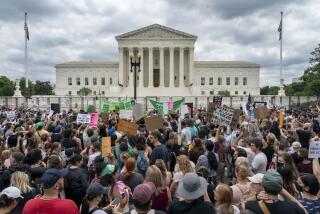The ‘80s: ‘Greenhouse for Teen Pregnancy’
- Share via
For many family planners, this wave of teen births was not just hard to understand, it was unthinkable.
In the nearly three decades following the post-World War II baby boom, teen birth rates steadily declined nationwide as prosperity, feminism and contraception widened young girls’ horizons. Partly because of abortion, teen births went down even in the face of increased sexual activity.
Then, in 1987, teen births started rising across the country.
“Back at the start of the family planning movement, our attitude was that all you needed to do was to get the information out. Then people would make the best decisions and there would be no more unintended teen pregnancies,” says Lisa Kaeser, senior public policy associate at the Alan Guttmacher Institute in New York, which specializes in reproductive health issues.
“But we found out that pregnancy has a lot to do with the growing gap between rich and poor.”
Many experts now say the 1980s provided greenhouse conditions for teen pregnancy. Economic trends, from the fraying of the union label to the glorification of greed on Wall Street, had an impact on many of today’s teen parents in Los Angeles, who watched their parents lose jobs in factories and defense plants.
Drugs, divorce and foster care weakened families. In some neighborhoods, more young men entered prison than college. Some neighborhoods were turned into polyglot patchworks by immigration, or reduced to puzzle pieces by gangs. Budget shortfalls erased after-school programs. Dropout rates soared; literacy rates dropped.
At the same time, the “baby boomlet” hit as career women who previously had delayed childbirth began having babies.
Meanwhile, the average adolescent was being exposed to 14,000 instances a year of glamorized sex on TV--only 165 of which were linked to topics related to education or contraception. Sexual activity was at least as high in European countries as in the United States. But teen pregnancy rates in England and France, where contraception is far more common, were only half as high.
At the same time, the American stigma against teen pregnancy--that diaphanous cultural contraceptive--began wearing thin.
Sex became commonplace among high school students, yet fewer than 60% had received sexuality classes by the time they graduated. A total of 68% had talked about sex with their parents--although more than half the girls and a three-fourths of the boys said their parents had never discussed birth control.
So, sex and ignorance led to a foreseeable outcome: By the end of the “Me Decade,” one of every 10 girls was pregnant before her 20th birthday. And while only one-third of all teen mothers were unmarried in 1973, two-thirds were unmarried in 1989.
Because most teen pregnancies were unintentional, about 43% were ending in abortions. But the Reagan Administration slashed budgets--not just for abortions, but for health clinics, sex education and birth-control programs as well. Just as teen births soared, 1,000 clinics were closing.
“The problem is becoming very severe,” says Dr. Ezra C. Davidson Jr., chairman of obstetrics/gynecology at Martin Luther King Jr./Drew Medical Center and former president of the American College of Obstetrics and Gynecology. “You have young, immature parents--usually just the mother--trying to raise a baby.”
“This,” Davidson concludes, “is a social time bomb.”
More to Read
Sign up for Essential California
The most important California stories and recommendations in your inbox every morning.
You may occasionally receive promotional content from the Los Angeles Times.













